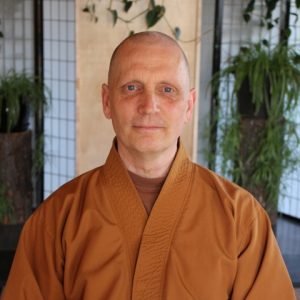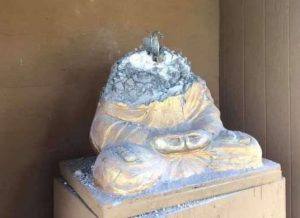
The 100-day Mahamudra Ocean of Certainty Transmission commenced on 1 September at Palpung Sherabling Monastic Seat in Himachal Pradesh, northern India. The transmission is taking place at the new shedra (monastic college) in the main hall, recently inaugurated by teachings and empowerments by both His Holiness the Dalai Lama and His Holiness the Karmapa on separate occasions.
A 100-day transmission is a rare but an important occurrence, and several hundred members of the Tibetan speaking sangha from Bhutan, China, India, and Nepal—mostly monastics but also lay Buddhists—enrolled for the program. The commitment of those present is strong as the practice is long and intense, making it a suitable only for the most committed and motivated.
Palpung Sherabling Monastery is the monastic seat of the Tai Situpa, one of the highest ranking lamas of the Karma Kagyu lineage. The lineage of the Chamgon Kenting Tai Situpas starts with the bodhisattva Maitreya, a direct disciple of Shakyamuni Buddha who lived some 2,600 years ago. Chokyi Gyaltsen was the first incarnation of the bodhisattva Maitreya to bear the title Situpa (Chinese: 大司徒, Dà Sītú), given to him by the Ming dynasty emperor Yongle in 1407. The 5th Tai Situpa, Chökyi Gyaltshen Palzang, received the Red Crown from the Gyalwang Karmapa, and since then the lamas of the lineage have been known as Chamgon Kenting Tai Situpas.
The 12th and current Tai Situ, Pema Tönyö Nyinje Wangpo, was born in Tibet and was one of four pupils of the 16th Karmapa. A karmic bond seems to tie the Tai Situs to the Karmapas as one has been recognizing the other in successive incarnations across generations. The current Tai Situ was recognised by the 16th Karmapa and he, in turn, recognised the current 17th Karmapa.

The mahamudra
The mahamudra originates from the time of the Buddha, and means “great seal” in Sanskrit (in Tibetan it is called phyag rgya chen po–phyag: “wisdom,” rgya: “this wisdom transcends defilement,” chen po: “wisdom and defilement are non-differentiable”—because they express a sense of unity). The origin of the mahamudra can be found in both the sutras and tantras:
The Buddha described mahamudra in various sutras, sometimes calling it mahamudra and sometimes not meaning: phenomena are naturally pure and sealed as primordially liberated. This is how mahamudra is described in the sutras.
In the tantras: mahamudra is taught in all four sets of tantras. It is taught in every tantra in the unsurpassable yoga tantras, and in the lower tantras it is spoken of as the “hand seal”—just as you seal something closed with your hand, so too phenomena are sealed with their true nature, emptiness.
In addition, mahamudra is sometimes spoken of in terms of the four seals, or mudras. These are the samaya seal, the wisdom seal, the action seal, and the great seal, or, in Sanskrit, the samayamudra, the jnanamudra, the karmamudra, and the mahamudra (or dharmamudra).
Mahamudra is also taught in the Mahamudra Subtle Drop Tantra, which is not among the four sets of tantra but is instead part of the spiritual songs (doha) literature. In this particular context, subtle drop (Skt. bindu, Tib. tigle) means “without change:”
So mahamudra is taught in all the sets of tantras, especially in the fourth and highest set. It is elaborated particularly in the Kalachakra Tantra and the Mahamudra Subtle Drop Tantra.
(Excerpt from Essentials of Mahamudra: Looking Directly at the Mind by Khenchen Thrangu Rinpoche, 2014)
Mahamudra was first taught as a whispered transmission to predestined students through the lineage of mahasiddhas (accomplished yogis and forest dwellers of the strangest kind) such as Saraha, Maitripa, and Tilopa. Tilopa lived and practiced in the region where Sherabling now stands, so in a way mahamudra has come “home” after a centuries-long journey to Tibet. And 1,000 years later, Tilopa’s heritage still stands strong.

The teaching methods of Tilopa were often unorthodox: he once asked his student, Naropa, to jump from a cliff and he hit him with one of his shoes. The current Tai Situ, however, reassured the sangha that he follows a much kinder approach. Large groups of students are instructed in mahamudra using the reference text Ocean of Certainty written by the 9th Karmapa, Wangchuk Dorje. Traleg Kyabgon has written an English-language commentary on the Ocean of Certainty.*
In the days of Tilopa, before mahamudra reached Tibet, only a few predestined individuals met with the teachings and attained enlightenment. In our time, through the dramatic exodus of Tibetan Buddhism to India and the West, the mahamudra teachings have become accessible to anyone who possesses the right karma and motivation.
The study and practice of mahamudra has become rather fashionable in recent years and is taught by many teachers worldwide. Yet a 100-day transmission, as is taking place at Palpung Sherabling, is rare, not only because of its duration and intensity, or the fact that the transmission is entirely in Tibetan, but also because the transmission comes from the current head of the Kagyu lineage (the 17th Karmapa), who is an emanation of Vajradhara. And Vajradhara is said to have taught mahamudra to Tilopa more than 1,000 years ago.
The 100-day transmission
A schedule hangs on the walls at Palpung Sherabling listing the times of the six daily sessions in which the Mahamudra Ocean of Certainty is explained and commented on. At the end of each of the 100 days, the meditation, the recitation of the text, the commentary, and the explanation is followed by a Mahakala Puja.
As the participants enter the teaching hall, they leave their lives—their karma, names, nationalities, and age—behind them. During the transmission they temporarily become bodhisattvas focused solely on releasing a subtle yet powerful beam of consciousness, as they are transported as if on a wing to higher planes of consciousness; to the ocean of certainty. Their sole intent is to experience Buddhahood, to learn how to consolidate their experience and how to sustain it across lifetimes, and to help other sentient beings do the same.

The atmosphere at the transmission is as if the great mandala of universal pristine awareness is being opened, resonating far and wide. Through the narrow passage of transmission and practice, the Tai Situ casts a magical net where people who fall out of samsara are piously caught and safely ushered through the door of liberation from an ocean of uncertainty and suffering into the the ocean of certain bliss.
Interviewing the participants makes little sense; the majority speak little to no English and they are not encouraged to speak about their practice. When approached, they look a bit blank and point away, saying, “You should speak with so and so.”
The practitioners do not speak much about the teachings and the practices for a number of reasons: first of all, there are no words or concepts to describe the deep experiences of elevation and expansion of consciousness they experience during the transmission, and secondly, nobody wants their experiences splattered all over the news because these experiences can be pretty emotional, sometimes even Earth-shattering and mind-blowing, and they can easily become the object of derision. The path to liberation is a personal one, it is transcendental and cannot easily nor convincingly be described.
Finally, the true mahamudra experience, the one that the Tai Situ transmits, will often wipe out any logic explanation or recollection of what happened during the sessions. So when the practitioners leave the teaching hall, they feel as if they have been outside space and time itself and often cannot recollect let alone narrate what happened during the session. Where did the time go, and what exactly was it that the teacher taught?
Yet, nobody thinks of the event as a waste of time, even though they have trouble recollecting the event. Mahamudra is something that primarily takes place in the heart, and the less we speak and write about it, the better. One thing, however, is clear: whether consciously or not, the aim of the exercise is to benefit all sentient beings, so even those who may not attend should be grateful and are unconsiously a part of it.

Although the actual practices are kept guarded—mostly because they do not make sense to the uninitiated and may be misunderstood or even mislead potential followers when taken out of context—mahamudra seems to be the surest and shortest path to enlightement, if one exists.
According to tradition, mahamudra practitioners do not in general enrol in specific programs, nor do they speak any language in particular, instead they find a way to communicate with their hearts. Although taught by a variety of teachers in different contexts, who use different texts and translations, mahamudra is about connecting and merging with the essence of everything. It is about breaking down conceptual and language barriers to expand the individual awareness of each practitioner and merge into the vast expanse of the universal ocean of consciousess, which is beyond date, place, and well beyond the six daily sessions of the initiation.
Can the ultimate transcendental teaching of the essence of everything be constrained to a few people sitting in a room speaking one language, with a registration card hanging from their necks? Can the wisdom of an entire lineage of enlightened masters be constrained to 1,000 people in 100 days?
The purpose of this practice is to reach out to the buddha-nature of all living beings, the intensity of the spiritual vibrations coming from the strong will and aspiration of Vajradhara reaches out, through the forest surrounding the shedra touching upon the golden rooftops of all the monastries in the surrounding areas and into the hearts of those who sit scattered everywhere truly aspiring for happiness and liberation.
References
Thrangu Rinpoche. 2014. Essentials of Mahamudra: Looking Directly at the Mind. Somerville: Wisdom Publications.
Ribush, Nicholas (ed.). 2005. Teachings From Tibet: Guidance from Great Lamas. Boston: Lama Yeshe Wisdom Archive.
See more
Dalai Lama Arrives at Palpung Sherabling Monastery – Upper Bhattu, HP, India (The Office of His Holiness the Dalai Lama)
The Historic Visit of the Gyalwang Karmapa to Palpung Sherabling Monastery (Kagyu Office)
The 12 Palpung Chamgon Kenting Tai Situ Rinpoches (Palpung Europe)












